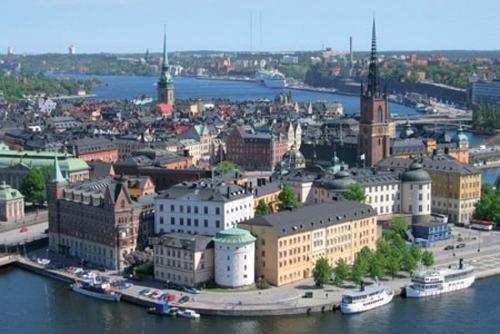
Day 1
God kveld fra Norge!!! In case you don’t speak Norwegian (and haven’t learned the beauty of google translate) that means, “Good evening from Norway!!!“
Well, I’m not writing this from Norway, but I just got off a skype call with Keith and the group arrived safely and had a great first day. Their adventure began in the wee hours of the morning and thus everyone slept well on their first flight. Upon arriving in Norway, their first impression was that it’s very, very quiet. They were astonished at the difference between what they’re used to back in Jerusalem and Tel Aviv – where cars and buses speed by, pedestrians congregate, and music can be heard from homes or car radios in the streets. On the contrary, Norway is quiet. There are electric cars, very little traffic, the people are calm and the general atmosphere is serene. Some of the students found it peaceful, others found it disconcerting. The ones who found it disconcerting probably didn’t catch the news out of Tel Aviv today – 8 people perched themselves on a bridge over Dizengoff Center in Tel Aviv and threatened to jump in protest of the socioeconomic conditions in Israel. I call that disconcerting. I think I’d enjoy Norway. By the way, the 8 protesters didn’t jump in the end.
Back to Norway.
After checking in at the hotel, which is very cute and in a great location, they headed out for a full day of exploring. Their first stop was the Nobel Peace Center Museum.
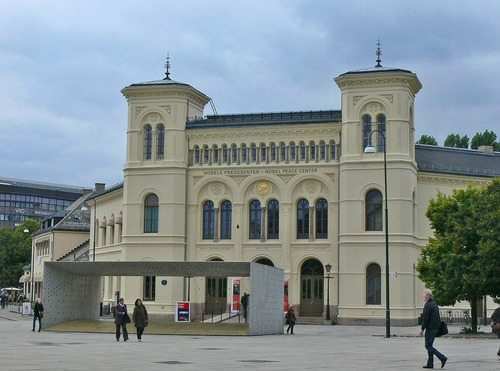
They explored the current exhibit, “Sheroes” which celebrates Women Heroes. This past year, the Nobel Peace Prize was awarded to three women: 2 from Liberia and 1 from Yemen “for their non-violent struggle for the safety of women and for women’s rights to full participation in peace-building work”. You can read more about these women at http://www.nobelprize.org/nobel_prizes/peace/laureates/2011/ or watch short interviews of each at http://www.nobelpeacecenter.org/en/exhibitions/sheroes-nobel/)
Next the students explored Frogner Park which contains statues by Norway’s greatest sculpture Gustav Vigeland. His amazing bronze and stone statues decorate the park which is one of Oslo’s top tourist attraction and is open 24/7 with no police, no crime and no graffiti.
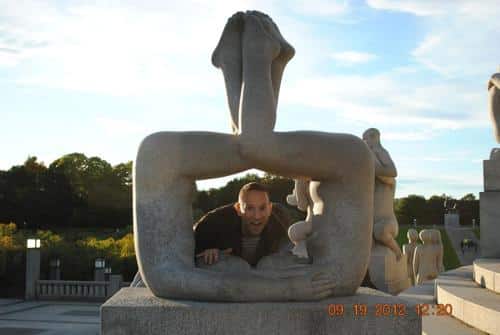
The rest of the day was rounded out with a lot of walking and simply exploring the city by foot. They are enjoying nice weather – it’s not too cold and the sun was shining! They also enjoyed a great dinner at an Indian Restaurant. Since everyone’s exhausted from their first day of traveling, they made it an early night and they’re looking forward to another great day tomorrow.
I’ll be updating you each day and will share more Norwegian with you. But, before I leave you today, here’s a little trivia for you… Did you know that the currency used in Norway is NOT the Euro? Nope, Norway didn’t join the EU. Their money is the Norwegian Kroner.
Until tomorrow, wishing all of you a Shana Tova, a year filled with good things, good travels, and good times!
Day 2
Hva en spennende dag i dag var! (What an exciting day today was!) Now, if any of you can pronounce “hva” without it sounding like hava nagila, I’ll be impressed…
Today was a REALLY packed day for the group in Norway. They laughed, they cried, it was better than Cats! I know the students won’t get that reference, but I’m sure you parents will 🙂 This is going to be a long update, but it’s worth reading to the end. Trust me.
After a wonderful breakfast at the hotel, the group took their first tram ride down to the port and sailed by ferry to the Bygdoy neighborhood which is on a peninsula just across from the harbor of downtown Oslo.
Then they headed over to the Fram Museum where they boarded an actual Artic exploration ship. They learned about the Norwegian explorers and their significant accomplishment of being the first to arrive at the South Pole. (The British tried and failed.)
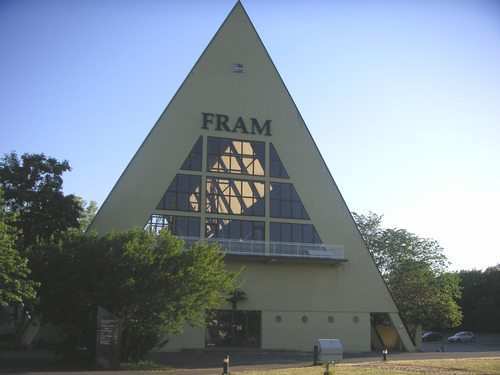
Next they headed over to the Kon-Tiki Museum where they learned about the explorer Thor Heyerdahl and saw the ancient “boats” that he explored with. Now, Wikipedia calls his boats “rafts” and if you check out the photos, I think you’d agree, that calling them boats is really stretching it. Why is it important? Well, imagine sailing in 1947 across the Pacific Ocean from South America to the Polynesian islands. What kind of vessel would you want to be on? At the museum, they saw two different boats he used and learned that his sailing exploration was an attempt to prove a theory that it was possible to sail on primitive boats to explore and settle new lands. One of his voyages lasted 101 days on a little thatched straw boat. It’s a miracle he survived (later the feasability of his plan was proven wrong despite his success in making it across the ocean.) The students also saw part of an academy award winning documentary which was made about Kon-Tiki. Click here to watch the trailer for the movie.
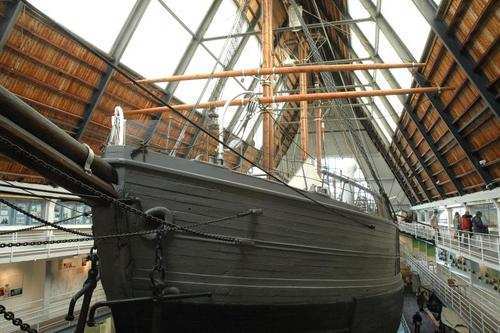
Moving away from the maritime history of Norway to the Jewish History of the country, the group next visited the Norwegian Holocaust Center which gave them a high-tech walk through the rise of anti-Semitism, the Holocaust in Norway, and racism today. They were very moved to learn about the Norwegain Jews and their history. Historically, the Jewish community was always relatively small. During WWII, approximately 1100 Jews escaped to neutral Sweden. 782 were caught and deported to Auschwitz – only 24 lived and returned to Norway. Although there were many Norwegians who helped to save Jews during the war, there were also many, including the police, who collaborated with the German Nazis and aided in the rounding up and deportation of the Jews. In fact, the government of Norwegian politician, Vidkun Abraham Lauritz Jonssøn Quisling, who served as President from 1942-1945, was a collaborationist government in Hitler’s Final Solution and Quisling was actually tried and executed after the war. During the Holocaust, the word “quisling” became a synonym for traitor. The Holocaust museum is in his former home, a mansion.
At the conclusion of their visit to the museum, the group held a short Memorial Ceremony for the Norwegians who perished in the Holocaust. Guy and Jordy read passages from two righteous gentiles who saved Jews despite the risk it placed them in and Mark led the group in mourner’s kaddish.
Today the students got their first taste of typical Norwegian food. For lunch they ate at a cute restaurant which was very old fashioned and throughout the restaurant antiques were displayed and for sale as well.
In the afternoon, the group headed over to the Viking Ship Museum which was definitely a highlight for them. They could not believe that the viking boats actually made it across the ocean. They are not so big and they’re made of wood. This museum was the only place they’ve seen so far that there are guards – security ensuring that no one touches the boats as they are important relics for the country. There were also a lot of other artifacts from the viking period as well, including shoes which showed them that the vikings weren’t so tall 1000 years ago.
Next they enjoyed the home hospitality of Leif and Inglelisa Grusd. The Grusd’s are one of Norway’s Jewish families (out of only 1500 in the whole country today). They have lived in Norway their whole lives and survived the Holocaust. They talked to the group about being a Norwegian Jew at the time of the Holocaust and the Jewish community in Norway today. Their home is in the Oslo suburbs and it was lovely. Leif is a dentist (and has traveled to Israel to volunteer his time a number of times over the years.) Inglelisa is a distributor for the Gotex Israeli swimwear company and she’s a wonderful hostess – the students really enjoyed her amazing apple cake.
When Leif was 12 years old when he was smuggled out to Sweden by non-Jews in order to avoid deportation to Auschwitz. He and his family were then in a DP camp and they lived there for three years not knowing what would happen to them. When the war ended, they went back to Norway. He described the experience actually as fun for a child who saw it as an adventure and didn’t understand the danger that they had been in.
Inglelisa’s story was much different. She was 10 months old when her father left to Sweden at the time when the Jews feared the men would be deported. The women and children who were left behind were required to check in at the police station each week. One week, a police man took her mother aside and told her that her kids looked like they need to take a long walk. She didn’t understand what he was trying to tell her and she returned home, she did nothing. The following week he said the same thing and was insistent that she must not have understood her. So she contacted the underground and prepared to leave. She went to the pharmacy to get something she could use to drug her baby (Inglelisa) so that she wouldn’t cry during the journey and risk their being discovered. But, as it turned out, the underground refused to take them because of the baby. She was turned away. As the situation got worse, her mother realized she needed to find a way to leave Norway. Her sister-in-law was in a similar situation with a baby of the same age and she decided she would not leave her baby and she would take her chances in Norway. Inglelisa’s mother found someone who agreed to take her baby and promised to try to find a way to smuggle the baby out. And, she left not knowing if she would ever see her child again. Eventually, baby Inglelisa was smuggled out of Norway and reunited with her family. Sadly, her aunt and cousin, who stayed in Norway were ultimately deported to Auschwitz. Despite Inglelisa’s survival, her mother was never the same – the act of abandoning her child was a decision she could not resolve for herself, even through that choice meant saving her daughter’s life. Years later, as an adult, Inglelisa tried to find the police man and the family took her and managed to get her out of Norway, but she was unable to find them. Everyone had used fake names to protect themselves.
On a lighter note, the group set out this evening to the National Theater to see one of Norway’s most famous plays called “About Peer” which is based on the fairy tale Per Gynt. It was a one man show and Keith managed to arrange prior to the trip front row center seats for them. The stage was set, the lights went down, the actor appeared, and……… he was speaking in Norwegian. The play was supposed to be in English. (Remember, front row center seats.) So, the students and Keith look at each other and Keith tries to convince everyone quietly that it must just be an introduction and soon he’ll switch to English. But, he didn’t. (Front row, center seats.) They had no idea what to do. It became clear that this was going to be a play in Norwegian. An hour and a half of Norwegian. The audience is laughing, the students and Keith are giggling and trying to decide what to do, how to get out of there without causing a scene (yes, my choice of words was intentional.) More Norwegian and now people around them are shushing them because they’re quietly taking among themselves deciding what to do. Keith decides they have to leave – they can’t sit through an hour and a half of
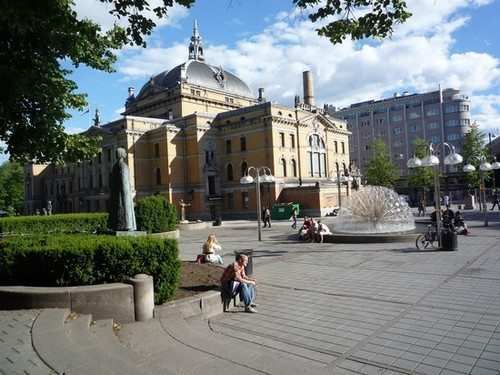
I gamle dager bodde det i Kvam jeger, som het Per Gynt, og som alltid var sentrale om i fjellene etter bjørn og elg, for i de dager var det mer skog på fjellet enn det er nå, og dermed rikelig av ville dyr. En kveld sent på høsten, lenge etter kveget hadde forlatt fjellet, Per legger ut på en av sine vanlige ekspedisjoner. Alle seterjenter hadde også gått bort, bortsett fra de tre jentene på Vala meieri. Da Per kom opp mot Høvring, hvor han skal bo for natten i en øde meieri, det var så mørkt at han nesten ikke kunne se en armlengdes avstand før ham. Hundene begynte barking voldsomt, og det var helt veldig trist og ubehagelig. Plutselig løp han mot noe, og da han stakk hånden ut, følte han at det var kaldt og glatt og svært store. Som han ikke tror han hadde gått av veien, hadde han ingen anelse om hva dette noe kan være, men ubehagelig var det i alle fall.
They get up and leave. The ushers are ushering the six of them out and the audience is shocked. The actor apparently made light of the fact that the six people in the front row center have just left in the middle of his solo performance. They get to the lobby and the realize, wait, only six of them left. Mark sat frozen in his seat, too embarrassed to get up and leave (or wanting to show respect?) Now Keith tries to go back in and the ushers won’t let him. They asked the ushers to go get Mark – they refused, unwilling to disturb the performance again. Mark sat through the whole play – an hour and a half – in Norwegian. Everyone had a great laugh and I’m sure they’ll remember their experience at the Norwegian National Theater for years to come! The theater refunded the tickets and the group treated themselves to an evening at TGIFridays for a taste of America after their authentic Norwegian experience.
So, in one day, they laughed (hysterically), they cried, and it was certainly better than Cats!
Day 3
It has been another great day in Norway!
This morning, our Aardvarkers were guests of the Israeli Embassy and had a wonderful visit. Everyone they met there was very friendly and they had the chance to meet with several different staffers, including the Ambassador! One of the most remarkable things about the Israeli Embassy in Norway is that it is the most culturally diverse of all Israeli Embassies worldwide. The students saw that first hand in the people they met. For example, one attaché they met was a Norwegian, non-Jewish man from the far north of Norway. He previously served Norway in the UN. The cultural attaché is an American woman, named Karen, whose mother is Norwegian. When she finished high school, she decided to do a gap year in Norway and ultimately she stayed. She also is not Jewish and did not have a particular connection to Israel, but she had a neighbor who worked at the Israeli Embassy and through their friendship she became interested in Israel. The Assistant to the Ambassador is a Jewish woman named Barbara who is originally from NJ. All these individuals took time to speak to the students, but their stories and backgrounds are not what really makes this Embassy so special.
The Israeli Deputy Ambassador to Norway, George Deek, is a Christian-Arab from Jaffa, who previously served as the Deputy Ambassador to Nigeria. The Israeli Ambassador to Norway is a man named Naim Araidi. He is a Druze from the north of Israel and he is an accomplished poet and professor of Hebrew Literature. He taught at the Haifa and Bar-Ilan universities, served as the dean at the Arab Academic College for Education and is a member of the Sapir Prize board. In 2008, he won the Prime Minister’s Award for Hebrew Literature. He only recently arrived in Norway and in fact, just yesterday he met with the King of Norway to present his credentials as the new Ambassador (and because of that meeting, Keith had to rearrange the trip itinerary at the last minute – the group was supposed to have gone to the Embassy yesterday.

The Ambassador, spoke to the students about how the news media in Norway is typically very anti-Israel and his aim is to change that. He explained to the group that Judaism was actually illegal in Norway until the early 1800’s. In fact, Norway’s first constitution, written in 1814, included in the second paragraph a general ban against Jews entering the country. That ban was only lifted in 1851. At its height, the Norway Jewish community only included about 2000 people. Over time, Norway became known as a very tolerant society and in the early years of the State of Israel, they were very pro-Israel. That changed in more recent years and the general society has become much more pro-Palestinian. In 2006, there was a synagogue shooting in Oslo and many Jews in Norway do not wear kippot or other Jewish-associated items in public. The Ambassador explained that the shift is in part due to the diversification of the Norwegian population. Up until recently Norwegian was essentially a Christian, blonde, homogeneous society, but there has been a lot of immigration in recent years which has changed that demographic and there is a growing Muslim community in Norway today.
As they chatted with the Ambassador, he also shared with them that as a Druze growing up in Israel, a minority in society, he never felt discriminated against and he felt encouraged to pursue his studies and achieve in society. He talked about how despite all the conflicts in Israel, you can easily find Arabs who are heads of departments at hospitals, universities, and other prominent areas of society. He told the group that he thinks that the situation in Israel is not really a conflict between religions, but rather the product of jealousy. As Western society propels Israel forward, while at the same time Islamic society does not, a dichotomy was created that left the Palestinians essentially jealous of what they do not have or feel they can not achieve. The Ambassador explained that in Israel, no matter what your background is, if you want to work hard, you can succeed and rise up in society. It is that reality which he wants to promote in Norway so that the Norwegians understand that there is true coexistence and democracy in Israel among Israelis, whether Jewish, Druze, Christian, Muslim, or otherwise.
Before leaving, the Embassy staff gave each student a pin with the Norwegian and Israeli flags on it – a memento I’m sure everyone will enjoy having as a reminder of their trip!
After the embassy visit, the group headed to the Norwegian Resistance Museum where they learned about how Norway suffered and resisted the Nazi invasion in WWII. Apparently, Hitler was convinced that the major Allied invasion would be from Norway so he committed a lot of troops there. Norway acknowledges that there were a lot of collaborators who cooperated with the Nazis, but at the same time there were also a lot of resistors and in general Norway as a state tried to stay out of it. The King of Norway actually refused to cooperate with Hitler and he ultimately fled to England only to return to Norway after the war.
Next they were off to the National Gallery where Norway’s cultural and natural essence is captured on canvas. Most importantly, are many of the works of Munch and they saw his famous “Scream” picture.
This evening they are headed out to the theater again, this time the language won’t matter though! They are going to a dinner theater for a show called “Reflection!” which involves singing, dancing, and acrobatics (and is geared to an international crowd.) In between the performances a four-course dinner is served by the performers to the audience members.
Ha en flott helg! Have a great weekend!
Day 4
First, a brief recap from last night… The dinner show was amazing! They loved it! It totally made up for the fashlah the night before (fashlah is Hebrew for “blunder” or “totally dumb and embarrassing thing that happened,“ ie, Keith taking everyone to a one-man show in Norwegian.) The theater was a multi-level venue and the actors performed not only on stage but also in the audience. And, they were the waiters as well. The whole show was in English and included popular music such as the Beatles and Lady GaGa (although the Beatles were performed by singers dressed as the Supremes and Gaga was performed by four men. The food was as great as the entertainment. At one point, a magician performed and even came over to the Aardvark table and did some tricks just for them.
Today was “Norway in a Nutshell,” taking the group through some of Norway’s most beautiful fjord scenery, across the country to the west.
The day began on the scenic Bergen Railway and then continued on the breathtaking Flam Railway.
On both of these journeys, the students enjoyed the amazing scenery, which included tiny villages, snow, waterfalls, and more. Along the way, the train stopped and they had the chance to get out, take photos, have a snowball fight, and enjoy their surroundings. On the first train, they traveled to the highest elevation in Northern Europe. At the top it was just snowy, blizzard-like conditions. The second train they were on – the Flam – is one of the world’s steepest railway lines with twisting tunnels that spiral in and out of the mountains and are know to be manifestations of the most daring and skillful engineering in Norwegian railway history.
At the end of the Flam train ride, they boarded a boat and sailed through the stunning fjords.
Finally, they took a bus journey, through windy roads, and more breathtaking scenery, with more stops along the way to enjoy the area.
After taking the train back to Oslo, they had the chance to go out and enjoy the nightlife tonight before they wrap up their adventure!
For en dag! What a day

















